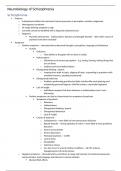Lecture notes
Molecular Basis of Neuropsychiatric Disorders (ANAT0012) Notes -
- Institution
- University College London (UCL)
Explore Intermediate Pharmacology at UCL with a focus on the Neurobiology of Schizophrenia chapter. Unveil the intricate interplay of epigenetics, genetics, and neuropsychiatric disorders. Dive into the neurobiology of mental diseases, spanning anxiety, learning, memory, depression, drug addiction,...
[Show more]




